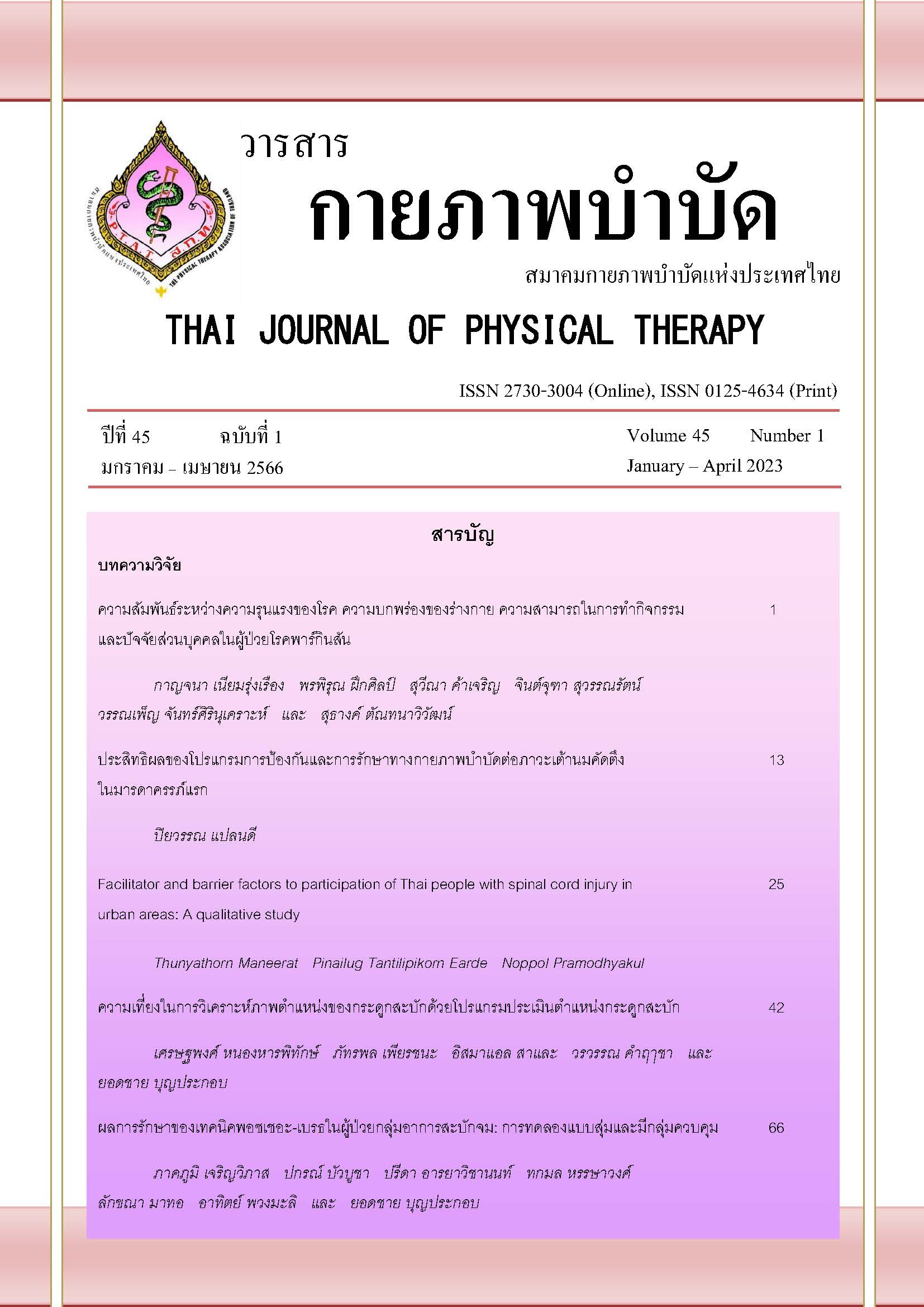ความสัมพันธ์ระหว่างความรุนแรงของโรค ความบกพร่องของร่างกาย ความสามารถ ในการทำกิจกรรมและปัจจัยส่วนบุคคลในผู้ป่วยโรคพาร์กินสัน
Main Article Content
บทคัดย่อ
ที่มาและความสำคัญ: โรคพาร์กินสันส่งผลกระทบให้เกิดความบกพร่องของร่างกาย ความสามารถในการทำกิจกรรม การเข้าร่วมทางสังคม และคุณภาพชีวิตที่ลดลง โดยบัญชีสากลเพื่อการจำแนกการทำงาน ความพิการ และสุขภาพ (International Classification of Functioning Disability and Health: ICF) แสดงให้เห็นความสัมพันธ์ ระหว่างสุขภาพและภาวะที่ส่งผลต่อสุขภาพ การทำงานหรือโครงสร้างร่างกาย การทำกิจกรรม การมีส่วนร่วมทางสังคม ปัจจัยสิ่งแวดล้อมและปัจจัยส่วนบุคคล ดังนั้นเพื่อการวางแผนการรักษาผู้ป่วยพาร์กินสันที่เหมาะสม นักกายภาพบำบัดควรทำการตรวจประเมินให้ครอบคลุมโดยพิจารณาองค์ประกอบทุกด้าน
วัตถุประสงค์: เพื่อวิเคราะห์ความสัมพันธ์ของความรุนแรงของโรค ความบกพร่องของร่างกาย ความสามารถในการทำกิจกรรม และปัจจัยส่วนบุคคลในผู้ป่วยโรคพาร์กินสัน
วิธีการวิจัย: ผู้ป่วยพาร์กินสันจำนวน 26 คน ได้รับการตรวจประเมิน 4 ด้าน คือ 1. ความรุนแรงของโรค (Modified Hoehn and Yahr: Modified H&Y) 2. ความบกพร่องของร่างกาย ส่วนที่ 3 ของ Unified Parkinson’s Disease Rating Scale: UPDRS III 3. ความสามารถในการทำกิจกรรม ประกอบด้วย การทำกิจวัตรประจำวัน ส่วนที่ 2 ของ UPDRS การทรงตัว (Berg Balance Scale: BBS) การเคลื่อนย้ายตนเอง (Time Up and Go: TUG) ความเร็วในการเดิน (10-Metre Walk Test: 10mWT) และความทนทาน (Six-Minute Walk Test: 6MWT) และ 4. ปัจจัยส่วนบุคคล ได้แก่ อายุ เพศ การรู้คิด (Thai Mental State Examination: TMSE) ผู้วิจัยวิเคราะห์ค่าความสัมพันธ์ของตัวแปรข้างต้น
ผลการวิจัย: Modified H&Y มีความสัมพันธ์ระดับน้อยถึงปานกลางกับ UPDRS II, UPDRS III และ BBS (r=0.46 – 0.59) TMSE มีความสัมพันธ์ระดับน้อยถึงปานกลางกับ TUG, UPDRS III, อายุ และ BBS (r=0.36 – 0.56) และ BBS มีความสัมพันธ์ระดับน้อยถึงปานกลางกับทุกการประเมิน (r=0.47 – 0.74) แต่ไม่พบความสัมพันธ์ระหว่างเพศกับทุกการประเมิน
สรุปผล: ความรุนแรงของโรค ความบกพร่องของร่างกาย ความสามารถในการทำกิจกรรม และปัจจัยส่วนบุคคลมีความสัมพันธ์ซึ่งกันและกัน ยกเว้น เพศ สำหรับการทรงตัวมีความสัมพันธ์กับองค์ประกอบทุกด้าน จากผลการวิจัยแนะนำให้นักกายภาพบำบัดควรทำการประเมินให้ครอบคลุมเพื่อให้การรักษาผู้ป่วยพาร์กินสันอย่างเป็นองค์รวม
Article Details

อนุญาตภายใต้เงื่อนไข Creative Commons Attribution-NonCommercial-NoDerivatives 4.0 International License.
เอกสารอ้างอิง
Charoensuksiri K, Charoensuksiri S. A Health-related quality of life and activities of daily living of Thai elderly people in Pathumthani Social Welfare Development Center for Older Persons. J Assoc Med Sci. 2017; 50(3): 516-24. (in Thai)
Hartelt E, Scherbaum R, Kinkel M, Gold R, Muhlack S, Tönges L. Parkinson's Disease Multimodal Complex Treatment (PD-MCT): Analysis of Therapeutic Effects and Predictors for Improvement. J Clin Med. 2020; 9(6): 1874-89.
Keus SHJ, Munneke M, Graziano M, et al. European Physiotherapy Guideline for Parkinson’s disease. 1st ed. Netherlands: KNGF/ParkinsonNet, 2014: 21-2.
Muangpaisan W, Siritipakorn P, Assantachai P. Development of a Thai Parkinson’s disease screening tool and the prevalence of Parkinsonism and Parkinson’s disease, Based on a community survey in Bangkok. Neuroepidemiology. 2017; 49: 74-81.
Peachpunpisal C. Caregiver in Parkinson’s disease patient. JPNC. 2015; 26(1): 111-6. (in Thai)
Falvo MJ, Earhart GM. Six-minute walk distance in persons with Parkinson disease: a hierarchical regression model. Arch Phys Med Rehabil. 2009; 90(6): 1004-8.
Brusse KJ, Zimdars S, Zalewski KR, Steffen TM. Testing functional performance in people with Parkinson disease. Phys Ther. 2005; 85(2): 134-41.
Yang Y, Wang Y, Zhou Y, Chen C, Xing D, Wang C. Validity of the Functional Gait Assessment in patients with Parkinson disease: construct, concurrent, and predictive validity. Phys Ther. 2014; 94(3): 392-400.
Gian Pal, Joan O Keefe, Erin Robertson Dick, Bryan Bernard, Sharlet Anderson, Deborah Hall. Global cognitive function and processing speed are associated with gait and balance dysfunction in Parkinson’s disease. J Neuroeng Rehabil. 2016; 13(94): 1-8.
Reekes TH, Higginson CI, Ledbetter CR, Sathivadivel N, Zweig RM, Disbrow EA. Sex specific cognitive differences in Parkinson disease. NPJ Parkinsons Dis. 2020; 6: 7.
Peachpunpisal C. Fall in Parkinson’s disease patient. JPNC. 2017; 28(2): 165-72. (in Thai)
Serrao M, Chini G, Caramanico G, Bartolo M, Castiglia SF, Ranavolo A, Conte C, Venditto T, Coppola G, di Lorenzo C, Cardinali P, Pierelli F. Prediction of Responsiveness of Gait Variables to Rehabilitation Training in Parkinson's Disease. Front Neurol. 2019; 10: 826.
Rittichuai R, Jitmanas A, Ruksachol O, Intarapak W, Khongnual N, Tunyarak H. Factors associated with dementia among the elderly in Nakhon Si Thammarat. JSCT. 2020; 13(1): 56-64. (in Thai)
Kanjananopinit S, Charoensak S, Keawpornsawan T. The study of Psychometric properties of cognistat Thai version. J Psychiatr Assoc Thailand. 2014; 59(4): 409-18. (in Thai)
Muangpaisan W, Assantachi P, Sitthichai K, Richarason K, Brayne C. The distribution of Thai Mental State Examination Scores among Non-Demented elderly in Suburban Bangkok Metropolitan and associated factors. J Med Assoc Thai. 2015; 98(9): 916-24.
Goetz CG, Poewe W, Rascol O, Sampaio C, Stebbins GT, Counsell C, Giladi N, Holloway RG, Moore CG, Wenning GK, Yahr MD, Seidl L; Movement Disorder Society Task Force on Rating Scales for Parkinson's Disease. Movement Disorder Society Task Force report on the Hoehn and Yahr staging scale: status and recommendations. Mov Disord. 2004; 19(9): 1020-8.
Steffen T, Seney M. Test-retest reliability and minimal detectable change on balance and ambulation tests, the 36-item short-form health survey, and the unified Parkinson disease rating scale in people with parkinsonism. Phys Ther. 2008; 88(6): 733-46.
Landers MR, Backlund A, Davenport J, Fortune J, Schuerman S, Altenburger P. Postural instability in idiopathic Parkinson's disease: discriminating fallers from nonfallers based on standardized clinical measures. J Neurol Phys Ther. 2008; 32(2): 56-61.
Vance RC, Healy DG, Galvin R, French HP. Dual tasking with the timed "up & go" test improves detection of risk of falls in people with Parkinson disease. Phys Ther. 2015; 95(1): 95-102.
Lindholm B, Nilsson MH, Hansson O, Hagell P. The clinical significance of 10-m walk test standardizations in Parkinson's disease. J Neurol. 2018; 265(8): 1829-35.
Cataneo DC, Kobayasi S, Carvalho LR, Paccanaro RC, Cataneo AJ. Accuracy of six minute walk test, stair test and spirometry using maximal oxygen uptake as gold standard. Acta Cir Bras. 2010; 25(2): 194-200.
Hamani C, Lozano AM. Physiology and pathophysiology of Parkinson's disease. Ann N Y Acad Sci. 2003; 991: 15-21.
Kim SM, Kim DH, Yang Y, Ha SW, Han JH. Gait Patterns in Parkinson's Disease with or without Cognitive Impairment. Dement Neurocogn Disord. 2018; 17(2): 57-65.
Haaxma CA, Bloem BR, Borm GF, Oyen WJ, Leenders KL, Eshuis S, Booij J, Dluzen DE, Horstink MW. Gender differences in Parkinson's disease. J Neurol Neurosurg Psychiatry. 2007; 78(8): 819-24.
Factor SA, Steenland NK, Higgins DS, Molho ES, Kay DM, Montimurro J, Rosen AR, Zabetian CP, Payami H. Postural instability/gait disturbance in Parkinson's disease has distinct subtypes: an exploratory analysis. J Neurol Neurosurg Psychiatry. 2011; 82(5): 564-8.
Shady NAA, Mansour AH, Khalefa AIM, Salem EY. Effect of endurance training on balance in Parkinson’s Patients. Med J Cairo Univ. 2020; 88(1): 31-38.


